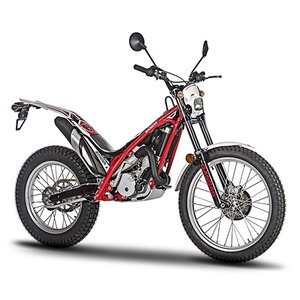GAS GAS TXT TRIALS 80 (2016-2019): A Trials Machine Built for Precision and Agility
Introduction
The GAS GAS TXT TRIALS 80 represents a focused evolution of Spanish engineering prowess in the trials motorcycle segment. Designed for riders who demand razor-sharp control and lightweight maneuverability, this 80cc two-stroke dominated youth and amateur competitions during its 2016-2019 production run. Let’s dissect why this bike remains a compelling choice for technical terrain enthusiasts.
Design Philosophy: Minimalism Meets Function
The TXT TRIALS 80’s design screams purpose. Its red/black/white color scheme isn’t just eye-catching – it’s a visual manifesto of GAS GAS’s racing heritage. The chromoly tubular frame keeps weight at 64 kg (141 lbs), crucial when you’re muscling the bike over boulders or pivoting mid-section.
Key design highlights:
- 590 mm (23.2") seat height: Low enough for quick foot dabs yet high enough for leg clearance during full compression.
- 1300 mm (51.2") wheelbase: The Goldilocks zone between stability and pivotability.
- Kickstart-only system: Reduces weight but demands proper technique – no push-button cheats here.
The 2.4L (0.63 gal) fuel tank isn’t meant for marathons. It’s a reminder: this machine exists for 2-3 hour trials, not cross-country adventures.
Engine Performance: The Angry Bee
At its heart lies a liquid-cooled 79.1cc two-stroke that revs like an angry hornet. The 43mm x 54.5mm bore/stroke ratio prioritizes torque over top speed – exactly what trials demand.
Carburetion nuances:
- 2016 models used Dell’Orto PHBG21DS
- Later years switched to PHBL21DS/BS variants
All versions shared crisp throttle response when properly jetted. The 6-speed gearbox is overkill on paper but proves useful linking technical sections.
Power delivery characteristics:
- 0-30% throttle: Manageable for beginners
- 30-70%: Linear torque surge
- WFO: Unnecessary in trials, but hilariously snappy
The hydraulic diaphragm clutch (GG 1/3 system) offers featherlight modulation – critical when balancing on rear wheels.
Handling: Mountain Goat DNA
Suspension setup:
- Front: 40mm adjustable telescopic forks (177mm/7" travel)
- Rear: Öhlins-style Olle monoshock (164mm/6.5" travel)
The suspension isn’t plush – it’s communicative. You’ll feel every pebble, but that’s the point. Setup tips:
- Soften compression for rocky riverbeds
- Stiffen rebound for log hops
Braking performance:
- Front: 4-piston floating disc – strong enough to stoppie up inclines
- Rear: 2-piston disc – modulate carefully to avoid washouts
Tire choice matters:
- Front: 1.60-19 (narrow for precise steering)
- Rear: 1.85-17 (bite without excessive bounce)
Competition: How It Stacks Up
The TXT TRIALS 80 faced fierce rivals:
1. Beta Evo 80
- Pros: Softer power delivery for novices
- Cons: Heavier at 67kg (148 lbs)
2. Sherco ST 80
- Pros: Innovative carburetor placement
- Cons: Less adjustable suspension
3. Ossa TR 80
- Pros: Fuel injection (in later models)
- Cons: Complex electronics for a trials bike
GAS GAS advantages:
- Best power-to-weight ratio in class
- Most customizable suspension
- Parts compatibility with bigger TXT models
Maintenance: Keeping the Spaniard Sharp
Critical upkeep areas:
- Carburetor Care
- Clean every 20 hours (trials dust is abrasive)
-
Upgrade to stainless jets (available at MOTOPARTS.store)
-
Air Filter Rituals
- Oil foam filter after every ride
-
Consider twin-air replacements
-
Suspension Service
- Change fork oil every 50 hours
-
Shock rebuilds annually for serious riders
-
Brake Upgrades
- Swap to sintered pads for wet conditions
-
Stainless brake lines improve feel
-
Drive Components
- Replace chain slider kits preventatively
- Ultra-light sprockets reduce unsprung weight
Conclusion: Timeless Trials Tool
The GAS GAS TXT TRIALS 80 isn’t about nostalgia – it’s a still-relevant tool for developing precise riding skills. While modern electric trials bikes gain attention, the visceral scream of its two-stroke and mechanical purity keep it alive in garages worldwide.
For owners looking to refresh their steed, MOTOPARTS.store offers everything from OEM-spec clutch kits to performance exhausts. Remember: in trials, the rider makes the difference – but having a well-prepped GAS GAS certainly helps.
Specifications sheet
| Engine | |
|---|---|
| Stroke: | Two-stroke |
| Fuel system: | Carburettor. Dell'Orto PHBL21DS/PHBG21DS (varies by submodel) |
| Displacement: | 79 ccm |
| Bore x stroke: | 43.0 x 54.5 mm (1.7 x 2.1 in) |
| Configuration: | Single |
| Cooling system: | Liquid |
| Lubrication system: | 2.5% premix oil |
| Number of cylinders: | 1 |
| Dimensions | |
|---|---|
| Wheelbase: | 1300 mm (51.2 in) |
| Dry weight: | 64 |
| Seat height: | 590 mm (23.2 in) (adjustable, lowest setting) |
| Overall width: | 745 mm (29.3 in) |
| Overall height: | 1040 mm (40.9 in) |
| Overall length: | 1870 mm (73.6 in) |
| Fuel tank capacity: | 2.4 L (0.63 US gal) |
| Drivetrain | |
|---|---|
| Clutch: | GG 1/3 hydraulic-diaphragm-system |
| Final drive: | chain |
| Transmission: | 6-speed |
| Additional Info | |
|---|---|
| Starter: | Kick |
| Ignition: | CDI digital magnetic flywheel |
| Color options: | Red/black/white |
| Chassis and Suspension | |
|---|---|
| Frame: | Chrom-Molybdenum tubular frame |
| Rear tire: | 1.85-17 |
| Front tire: | 1.60-19 |
| Rear brakes: | Single disc, 2-piston caliper |
| Front brakes: | Single disc, 4-piston caliper |
| Rear suspension: | Olle hydraulic mono shock |
| Front suspension: | Telescopic fork, 40 mm (Racing) / 33 mm (Pro), adjustable compression and rebound |
| Rear wheel travel: | 164 mm (6.5 in) |
| Front wheel travel: | 177 mm (7.0 in) |



















